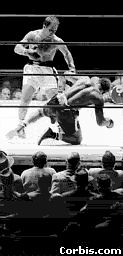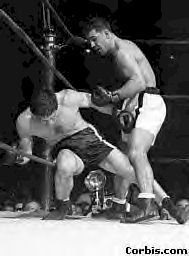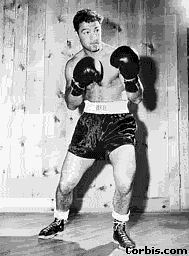
Rocky Marciano referred to “Suzy-Q” (his big right hand punch) when he
first came on the scene and the experts laughed. After they saw “the
Rock” flatten his opponents for a few years, they referred to “Suzy-Q”
and Marciano laughed.
Rocky came out swinging at the opening bell and maintained the attack until
he gunned his man down. He “let it all hang out” on each punch.
Everything seemed to ride on the one big smash. He was relentless in his
pursuit and like the Northwest Mounties, he usually got his man.
No one ever trained harder or took better care of himself than Marciano. He
is often compared to Jim Jeffries in terms of brute strength and described
as being crude, clumsy, strong, and able to hit. He could take a punch – a
punch of knockout caliber – and not blink.
Probably, a more likely comparison would be that of Marciano to the
“near-champion” Tom Sharkey (of the 1893-1904 period) or Joe Frazier and
Mike Tyson of more recent years. Rocky and Sharkey were similar in
size except that Sharkey was much larger through the chest. Both had awesome
hitting power and endurance, both sought victory any way they could get it,
and both were aggressive, rough, and dirty. Marciano possibly had the
tougher chin.
A stocky man with short arms, Rocky fought from a semi-crouch and bulled his 
opponents around with fierce determination using non-stop, swarming tactics.
His short reach forced him to get inside and work close. Fists, wrists,
forearms, elbows, head butts, and low blows comprised his arsenal.
Carpenter (1975 p 114) called him a ruthless attacker and a very dirty
fighter who always elbowed and butted. Houston (1975 p 75) said, “He was
crude and clumsy, but he was also strong and could hit. He trained
arduously,
knowing that because of his style he would have to take punches along the
way. Marciano developed into a human battering ram of a fighter, seemingly
able to take the hardest punches and come right back as if nothing had
happened.”
He asserted that Marciano came to fight and not play. Rocky took no time to
be nice. If punches went low or if he butted – too bad! (Hmmm, sounds like
Tom Sharkey.) He adds that Rocky’s blows were heavy and because he was not
a big heavyweight, he got close to his opponents and bulled them to the
ropes for body-pounding.

Cooper (1978 p 12) wrote, “he was a throwback to the old bareknuckle days.
He must have been one of the hardest, most physically durable heavyweights
of all time.” Cannon (1978 p 158) asserted, “The endurance of Rocky
Marciano was inhuman, and he was a mercilessly strong man. So hard was his
body that [Joe] Louis said he hurt you badly if he bumped into you.”
Odd (1974 p 49) described Rocky, “Marciano’s brand of belligerent
destructiveness had to be seen to be believed. There was no art or finesse
about his work, he just bulldozed in and took his opponents apart with his
hooks, swings, and uppercuts.”
Myler (1998 p 247) called him “one of the roughest fighters of them all”
and wrote, “He was in the ring to do a job and he did it whichever way he
could. If that meant hitting with his elbows, butting, punching low, or
after the bell had rung to end a round, then so be it.”
Al Weill, Rocky’s manager, said, “Rocky has something you don’t see
unless you’re around him all the time. After a while, you know it’s
there, and so do the guys who get in there with him.” He added that nature
gave him everything he needed as a champion – unusual strength, stamina, a
terrific punch, and plenty of guts (see McCallum 1975 p 58).
McCallum (1974 p 244) said, “Rocky Marciano might have been the crudest
heavyweight ever to get a crack at the world title, let alone win it, but no
one ever beat him.” He also asserted (1974 p 254), “With the possible
exception of Gene Tunney, no heavyweight could come close to matching the
dedication and self-discipline of Marciano.”

Grombach (1977 p 83) said that Marciano was “a dedicated, never-say-die,
superbly self-disciplined athlete with many physical handicaps. Only Gene
Tunney equaled the quite unannounced confidence, discipline, and
insurmountable will-to-win of Marciano, although Marciano’s physical
equipment was far inferior to Tunney’s.” He added, “Marciano may well
have been the hardest hitter in the game.”
Gutteridge (1975 pp 101-102, 107) described Rocky as a “strong,
undisciplined punch swinger” whose impact was that of “brute strength,
of almost animal crudity” and that it “mocked the very concept of craft
and skill.” He wrote, “Marciano’s forearm hitting was estimated to be
greater than some heavyweights can deliver with their full body force going
into a punch.”

Fleischer and Andre (1975 p 145) called him “a fighter with iron fists.”
Jack Kearns, Dempsey’s old manager, said “When it comes to one-punch
hitting, this kid is better than Dempsey and Louis” (see Durant 1976 p
119). Red Smith said Rocky “is known as the best one-punch hitter of them
all” (see Litsky 1975 p 220).
McCallum (1975 p 57) wrote, “Marciano reminded oldtimers of Dempsey. He
had a knockout punch in either hand. He took a punch beautifully. He had
guts, a fighting heart. He feared no man, and would not have feared
Dempsey.”
Gene Tunney thought a Dempsey-Marciano fight would have been a
“cheek-to-jowl brawl” and felt that Marciano had at least one asset that
matched Dempsey. Tunney stated, “Dempsey could take it. He could take it
to a full degree – and so could Rocky” (see McCallum 1974 p 257;
McCallum 1975 pp 56-58; and Rice 1954 p 131).
Charley Goldman said Marciano had a “steel-chin” (see McCallum 1974 p
248) and Carpenter (1975 p 114) testified that he never saw Marciano take a
backward step. Mee (1997 p 209) insisted, “Rocky Marciano was impossible
to discourage, and seemed impervious to pain.”
Durant (1976 pp 114-115) described Marciano as follows, “He had
determination, he had an exceptionally powerful build and he had a
blockbuster of a punch … he had enormous arms and shoulders and a pair of
hands like boulders.”

He further wrote (1976 p 123), “Ring critics do not rank Rocky with the
great ones, like Jeffries, Johnson, Dempsey, Tunney, and Louis. He never had
to face the topnotch fighters that they did. It was not Rocky’s fault, of
course, that there was not much talent in the heavyweight field when he was
fighting. He fought them all, and that is what a champion is supposed to
do.”
Myler (1998 p 246) wrote “Forty-nine fights. Forty-nine wins. Rocky
Marciano’s place in history as the only world champion with a perfect
record remains unchallenged.”

Herb Goldman, former Editor of The Ring Record Book and the International
Boxing Digest (IBD) monthly boxing magazine, ranked Marciano as the #7
All-Time Heavyweight (The Ring, 1987 p 1071). Charley Rose ranked him as the
#8 All-Time Heavyweight and Nat Fleischer ranked him as #10. The Ring (1999,
p 127) ranked him as the #6 All-Time Heavyweight and The Ring (2000, p 132)
ranked him as the #9 All-Time greatest fighter of the twentieth century
(among all weight classes). In the opinion of this writer, Marciano was the
#9 All-Time Heavyweight (and perhaps deserves an even higher ranking).
Reference
Cannon, J. and Cannon, T. 1978. Nobody Asked Me, But … (The World of Jimmy
Cannon). New York: Holt, Rinehart, and Winston.
Carpenter, H. 1975. Boxing : A Pictorial History. Chicago: Henry Regnery
Company.
Cooper, H. 1978. The Great Heavyweights. Secaucus, NJ: Chartwell Books, Inc.
Durant, J. 1976. The Heavyweight Champions. New York: Hastings House
Publishers.
Fleischer, N. and Andre, S. 1975. A Pictorial History of Boxing. Secaucus,
NJ: Castle Books.
Grombach, J. 1977. The Saga of the Fist. New York: A.S. Barnes and Company.
Gutteridge, R. 1975. Boxing : The Great Ones. London: Pelham Books Ltd.
Houston, G. 1975. SuperFists. New York: Bounty Books.
Litsky, F. 1975. Superstars. Secaucus, NJ: Derbi-books Inc.
McCallum, J. 1974. The World Heavyweight Boxing Championship. Radnor, Pa:
Chilton Book Company.
McCallum, J. 1975. The Encyclopedia of World Boxing Champions. Radnor, Pa:
Chilton Book Company.
Mee, B. 1997. Boxing: Heroes & Champions. Edison, NJ: Chartwell Books,
Inc.
Myler, P. 1998. A Century of Boxing Greats. New York: Robson/Parkwest
Publications
Odd, G. 1974. Boxing : The Great Champions. London: The Hamlyn Publishing
Group Limited.
The Ring. 1987. The Ring Record Book and Boxing Encyclopedia. New York: The
Ring Publishing Corp.
The Ring. 1999. The 1999 Boxing Almanac and Book of Facts. Fort Washington,
Pa: London Publishing Co.
The Ring. 2000. “The 20 Greatest Fighters of the 20th Century by William
Detloff” contained in The 2000 Boxing Almanac and Book of Facts. Fort
Washington, Pa: London Publishing Co.
Back To
WAIL! Contents Page
|